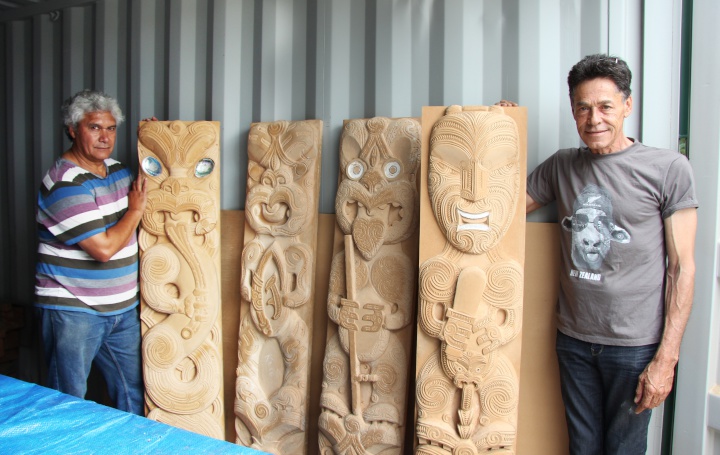Maori Carving Project Underway

Master carvers Te Rangi Robin (left) and Emanuel Dunn with pou whakairo.
Media Release
Maori Carving Project Underway
Traditional carvers are crafting pou whakairo in a long-term project aimed at furnishing the interior of the wharenui on EIT’s Te Ara o Tāwhaki marae.
Of Ngāti Kahungunu descent, local carvers Te Rangi Robin and Emanuel Dunn are based at EIT’s ideaschool, where they will be creating a total of 40 carved panels over the next 2½ years.
Traditionally, pou whakairo depict ancestors. However, because EIT is an educational institution, Te Rangi says a different concept has evolved.
Half the carvings are to represent Māori gods, he points out, while others will represent decades and achievements made for Māori during those times.
Director Māori Tuhakia Keepa says that when the wharenui was officially opened 23 years ago, it was always with a view to completing the interior.
“We had the opportunity this year to have a look at it.”
Tuhakia and Te Ūranga Waka’s head Puti Nuku jointly identified who might be included in the project.
As the faculty’s first dean, Joe Te Rito commissioned carvers, including Te Rangi, to design and work on pou whakairo for the exterior of the wharenui’s paepae (threshold) as well as other structures on the marae.
Invited to return, Te Rangi says it’s nice to be back on campus. Emanuel, who gained his Bachelor of Visual Arts and Design from EIT in 2010, agrees.
Enjoying working together, the pair have now carved four pou whakairo, using customwood rather than difficult-to-source native timber.
“It’s a kind of vocation with us,” says Emanuel. “We’ve been journeymen at the same time – we met in the carving shed and have crossed paths on quite a few projects now.”
Once their carvings are put in place, the men agree the result will be like a storybook, with the interior of the wharenui to be read in tukutuku (woven lattice-work), kōwhaiwhai (painted panels) and pou whakairo.


 NZ Principals Federation: Principals Describe Budget As Bitter Sweet
NZ Principals Federation: Principals Describe Budget As Bitter Sweet GfK Radio: Radio Listening Tops 3.5M Weekly Listeners
GfK Radio: Radio Listening Tops 3.5M Weekly Listeners  Jacob Douglas Motorsport: Douglas Heads To The Oval After Breakthrough Victory
Jacob Douglas Motorsport: Douglas Heads To The Oval After Breakthrough Victory Research For Maori Health and Development: Bridging The Gap In HIV Prevention For Māori - Insights And Resources Now Available
Research For Maori Health and Development: Bridging The Gap In HIV Prevention For Māori - Insights And Resources Now Available Tertiary Education Union: Weltec And Whitireia Cuts A Shocking Blow For Their Communities
Tertiary Education Union: Weltec And Whitireia Cuts A Shocking Blow For Their Communities PHARMAC: Pharmac Proposes To Fully Fund Nutrition Replacements For Some People With Crohn’s Disease
PHARMAC: Pharmac Proposes To Fully Fund Nutrition Replacements For Some People With Crohn’s Disease